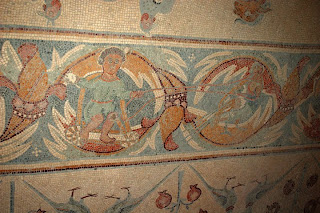One of the th

ings I have been looking forward to with the Endeavour fellowship has been to have the time to get involved in the life of Amman. So today Rose Espinola (fellow Aussie Endeavour researcher, here to look into discriminatory citizenship laws for women, and intersections of sharia and international law on same) started our art gallery crawl. Barbara Porter thought we could do the National Art Gallery, the Darat al-Funan ("House of Arts") and all the Second/First circle + Rainbow Street galleries in one day. Ha! Rose and I like our art slow.
 (Rose is photographing a giant slingshot called "Weapons of Mass Destruction" made by a Palestinian woman artist )
(Rose is photographing a giant slingshot called "Weapons of Mass Destruction" made by a Palestinian woman artist )
So we went off at about 10.30 - you don't want to rush this kind of thing - to Jebel Weibdeh, up from old Abdali where the Mattaf Watani (Art Gallery) is located in two buildings each side of a park which has been turned into the sculpture gallery, and Japanese garden.
I'm really disappointed that the Gallery shop did not have a single poster or postcard reproduction of any of the art in the Gallery, because some of it was just great. I'm going back to pick up the catalogue raisonne and a few other books on Jordanian artists next time I have a chance after work. I didn't have my act together to write down the names of the artists - will try and fix that later too - but here are some photos I stole (not sure on their policy about taking photos in the gallery, but heh, this is public relations):

Sculpture Park

It appears that the garbage bins of Amman breed in the Sculpture garden - or else they are Arabic daleks!
"Unity" - it's hard to tell, but the entire canvas is covered in calligraphy



Outfit from chocolate bar wrappers; I loved the pose of this Turkish oud player (1960s?) with his head back singingI really want one of these Palestinauts:

This made me happy (Tunisian):

This made me sad (Benin "The refugee baby's bottle"):

The Gallery is run by the Roya

l Fine Art Society which also provides workspaces, technical facilities and this excellent library and cafe upstairs in the main building. Last year when Rose was here learning Arabic, she came to the Gallery for art cinema evenings.
Then we walked through Jebel Weibdeh to Paris Square and had lunch at the Libr@irie Cafe (complet avec French chansons playing in the background) which has a room next to the ladies labelled, I am not joking, "Stuff Closet".
Then we walked past the Luzmila Hospital, founded by the Sisters of Nazareth in 1948, named after Contessa Luz Mila, a Bolivian woman whose second husband was a cousin of Prince Rainier and who donated the X-ray department to them, down the hill to the edge of Jebel Weibdeh to the
Darat al-Funan (click on link to website - I'm getting this blogging thing down now!)This is run by the Khalid Shoman Foundation (Arab Bank founders) and seems to be the spot for contemporary art.

It is made out of 3 1920s houses, and some archaeological remains (they claim a church and a temple - but I didn't see them this time around).

We'd left our run a bit late by this stage - the disadvantage of slow art - so only really saw the exhibition by Halim al Karim Witness from Baghdad. This is a pretty confronting photography exhibition. The photo here doesn't do the works justice.

The faces are so blurry that when you get close to the panel, you can't even see them. But the eyes, without even eyelashes, are perfectly in focus, stunningly printed in colour and absolutely mesmerising. The eyes refer back as far as Sumerian art, where the sculptors also paid particular attention to the overlarge eyes. These men were disconcerting enough, but at the other end of the room were triptychs of children. Each set was made of three views of the same child's head, using the same technique of b/w blurry faces and startling colour eyes. But their mouths were taped closed.
Shiver.
 (early page of homework - at least my handwriting is going well)
(early page of homework - at least my handwriting is going well)

































